2023 TOYOTA PRIUS PLUG-IN HYBRID headlights
[x] Cancel search: headlightsPage 339 of 818

3375-3. Operating the lights and wipers
Prius Plug-in Hybrid_OM_OM47F38E_(EE)
5
Driving
Headlight switch
Operating the switch turns on the lights as follows:
The headlights, front
position lights, daytime
running lights ( P. 338)
and so on turn on and
off automatically (when
the power switch is in
ON mode).
The front position, tail,
license plate and instru-
ment panel lights turn
on.
The headlights and all
lights listed above
(except daytime run-
ning lights) turn on.
With the headlights on, push
the lever away from you to turn
on the high beams.
Pull the lever toward you to the
center position to turn the high
beams off.
Pull the lever toward you and
release it to flash the high
beams once.
You can flash the high beams wi th the headlights on or off.
The headlights can be operated manually or automatically.
Operating instructions
1
2
3
Turning on the high beam headlights
IO53PH030
1
2
Page 340 of 818

3385-3. Operating the lights and wipers
Prius Plug-in Hybrid_OM_OM47F38E_(EE)
This system allows the headlights and front position lights to be turned
on for 30 seconds when the power switch is off.
Pull the lever toward you and
release it with the light switch in
the position after turning
the power switch off.
Pull the lever toward you and
release it again to turn off the
lights.
■ Daytime running light system
To make your vehicle more visible to other drivers during daytime driving, the
daytime running lights turn on automatically whenever the hybrid system is
started and the parking brake is released with the headlight switch in the
position. Daytime running lights are not designed for use at night.
■ Headlight control sensor
Extended Headlight Lighting system
IO53PH031
The sensor may not function properly if an
object is placed on the sensor, or anything
that blocks the sensor is affixed to the
windshield.
Doing so interferes with the sensor
detecting the level of ambient light and
may cause the automatic headlight sys-
tem to malfunction.
Air conditioning operation may also be interrupted.
Page 341 of 818

3395-3. Operating the lights and wipers
Prius Plug-in Hybrid_OM_OM47F38E_(EE)
5
Driving
■Automatic light off system
● When the light switch is in the or position: The headlights turn
off automatically if the power switch is turned to ACCESSORY mode or
turned off.
● When the light switch is in the position: The headlights and all lights
turn off automatically if the power switch is turned to ACCESSORY mode or
turned off.
To turn the lights on again, turn the power switch to ON mode, or turn the light
switch to the position once and then back to the or posi-
tion.
■ Automatic headlight leveling system
The level of the headlights is automatically adjusted according to the number
of passengers and the loading condition of the vehicle to ensure that the
headlights do not interfere with other road users.
■ Light reminder buzzer
A buzzer sounds when the power switch is turned off and the driver’s door is
opened while the lights are turned on.
■ 12-volt battery-saving function
In order to prevent the vehicle 12-volt battery from discharging, if the light
switch is in the position when the power switch turned off the 12-volt
battery saving function will operate and automatically turn off all the lights
after approximately 20 minutes.
When any of the following are performed, the 12-volt battery-saving function
is canceled once and then reactivated. All the lights will turn off automatically
20 minutes after the 12-volt battery-saving function has been reactivated:
● When the headlight switch is operated
● When a door is opened or closed
■ If “Headlight System Malfunction Visit Your Dealer” is displayed on the
multi-information display
The system may be malfunctioning. Have the vehicle inspected by any autho-
rized Toyota retailer or Toyota authorized repairer, or any reliable repairer.
■ Customization
Settings (e.g. light sensor sensitivity) can be changed.
(Customizable features: P. 726)
Page 344 of 818
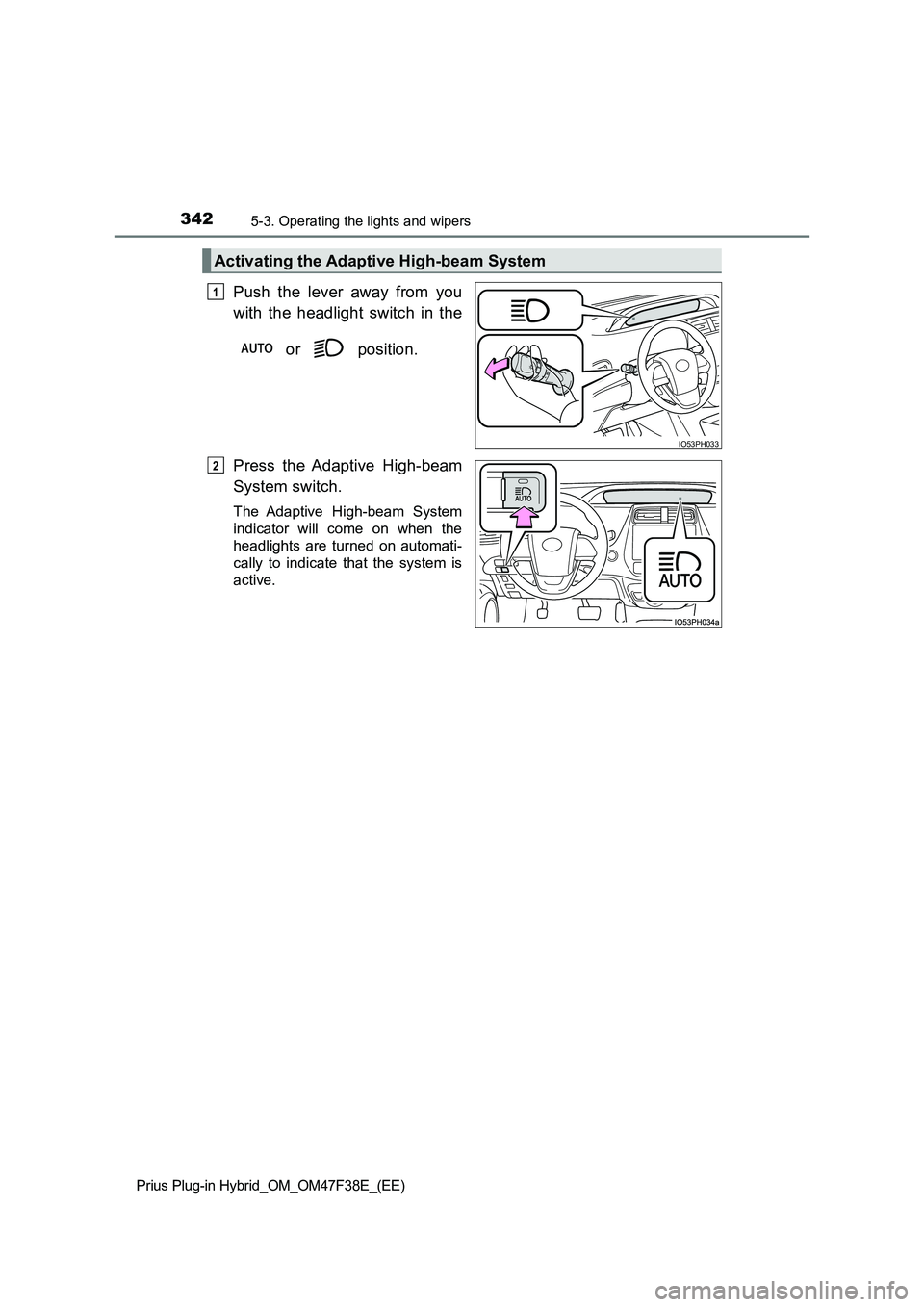
3425-3. Operating the lights and wipers
Prius Plug-in Hybrid_OM_OM47F38E_(EE)
Push the lever away from you
with the headlight switch in the
or position.
Press the Adaptive High-beam
System switch.
The Adaptive High-beam System
indicator will come on when the
headlights are turned on automati-
cally to indicate that the system is
active.
Activating the Adaptive High-beam System
IO53PH033
1
2
Page 346 of 818
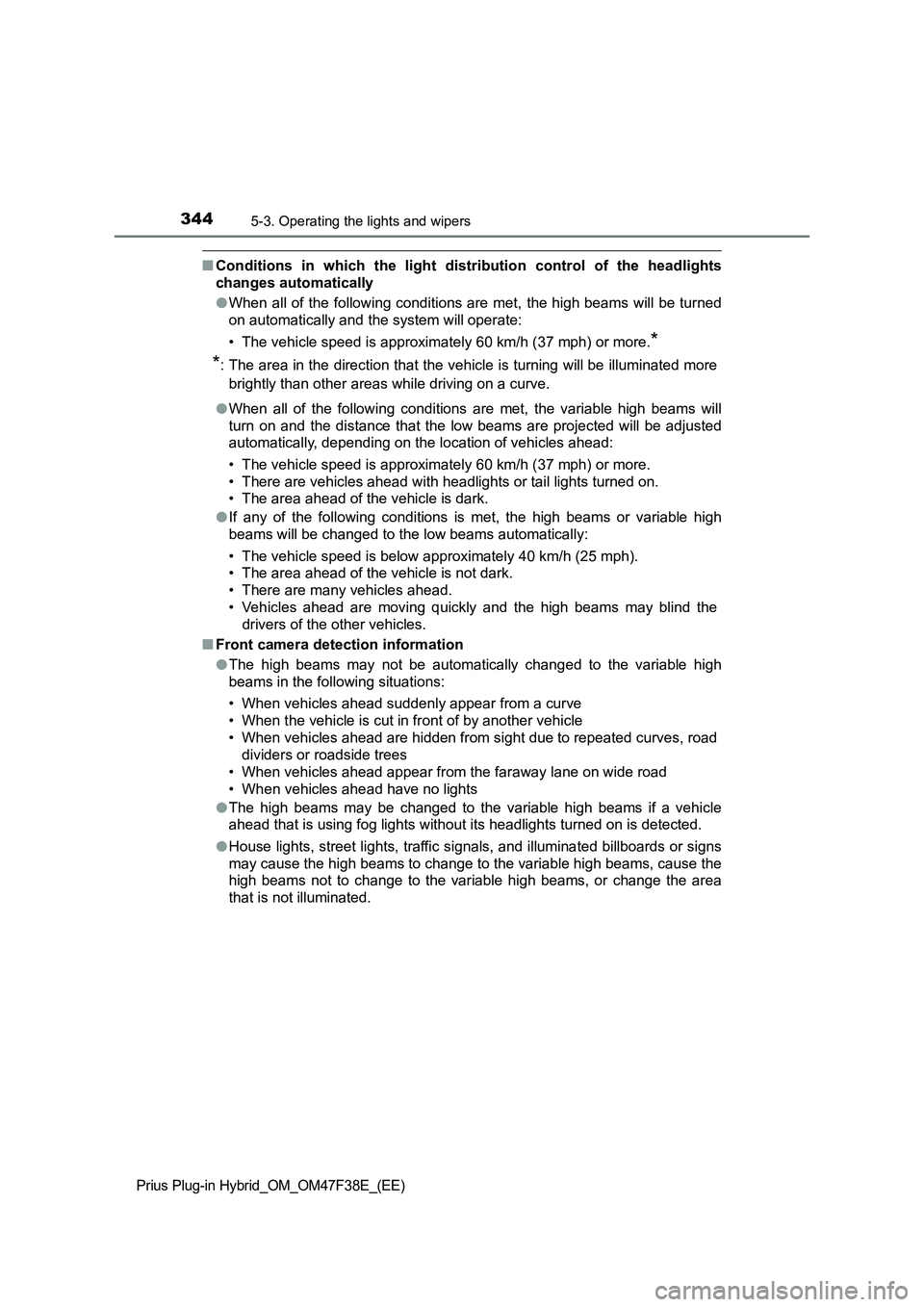
3445-3. Operating the lights and wipers
Prius Plug-in Hybrid_OM_OM47F38E_(EE)
■Conditions in which the light distribution control of the headlights
changes automatically
●When all of the following conditions are met, the high beams will be turned
on automatically and the system will operate:
• The vehicle speed is approximately 60 km/h (37 mph) or more.
*
*
: The area in the direction that the vehicle is turning will be illuminated more
brightly than other areas while driving on a curve.
●When all of the following conditions are met, the variable high beams will
turn on and the distance that the low beams are projected will be adjusted
automatically, depending on the location of vehicles ahead:
• The vehicle speed is approximately 60 km/h (37 mph) or more.
• There are vehicles ahead with headlights or tail lights turned on.
• The area ahead of the vehicle is dark.
●If any of the following conditions is met, the high beams or variable high
beams will be changed to the low beams automatically:
• The vehicle speed is below approximately 40 km/h (25 mph).
• The area ahead of the vehicle is not dark.
• There are many vehicles ahead.
• Vehicles ahead are moving quickly and the high beams may blind the
drivers of the other vehicles.
■Front camera detection information
●The high beams may not be automatically changed to the variable high
beams in the following situations:
• When vehicles ahead suddenly appear from a curve
• When the vehicle is cut in front of by another vehicle
• When vehicles ahead are hidden from sight due to repeated curves, road
dividers or roadside trees
• When vehicles ahead appear from the faraway lane on wide road
• When vehicles ahead have no lights
●The high beams may be changed to the variable high beams if a vehicle
ahead that is using fog lights without its headlights turned on is detected.
●House lights, street lights, traffic signals, and illuminated billboards or signs
may cause the high beams to change to the variable high beams, cause the
high beams not to change to the variable high beams, or change the area
that is not illuminated.
Page 347 of 818
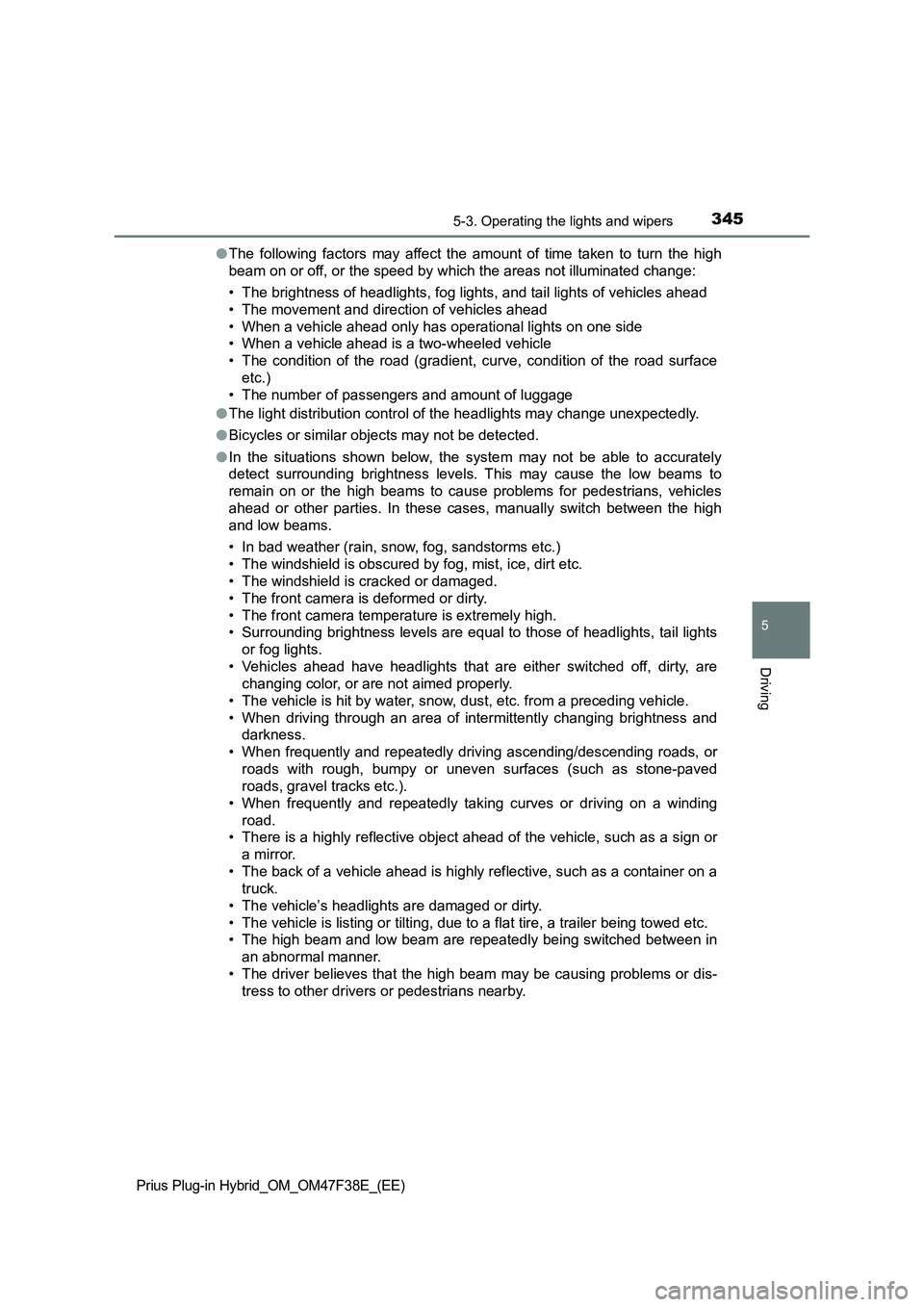
3455-3. Operating the lights and wipers
Prius Plug-in Hybrid_OM_OM47F38E_(EE)
5
Driving
●The following factors may affect the amount of time taken to turn the high
beam on or off, or the speed by which the areas not illuminated change:
• The brightness of headlights, fog lights, and tail lights of vehicles ahead
• The movement and direction of vehicles ahead
• When a vehicle ahead only has operational lights on one side
• When a vehicle ahead is a two-wheeled vehicle
• The condition of the road (gradient, curve, condition of the road surface
etc.)
• The number of passengers and amount of luggage
●The light distribution control of the headlights may change unexpectedly.
●Bicycles or similar objects may not be detected.
●In the situations shown below, the system may not be able to accurately
detect surrounding brightness levels. This may cause the low beams to
remain on or the high beams to cause problems for pedestrians, vehicles
ahead or other parties. In these cases, manually switch between the high
and low beams.
• In bad weather (rain, snow, fog, sandstorms etc.)
• The windshield is obscured by fog, mist, ice, dirt etc.
• The windshield is cracked or damaged.
• The front camera is deformed or dirty.
• The front camera temperature is extremely high.
• Surrounding brightness levels are equal to those of headlights, tail lights
or fog lights.
• Vehicles ahead have headlights that are either switched off, dirty, are
changing color, or are not aimed properly.
• The vehicle is hit by water, snow, dust, etc. from a preceding vehicle.
• When driving through an area of intermittently changing brightness and
darkness.
• When frequently and repeatedly driving ascending/descending roads, or
roads with rough, bumpy or uneven surfaces (such as stone-paved
roads, gravel tracks etc.).
• When frequently and repeatedly taking curves or driving on a winding
road.
• There is a highly reflective object ahead of the vehicle, such as a sign or
a mirror.
• The back of a vehicle ahead is highly reflective, such as a container on a
truck.
• The vehicle’s headlights are damaged or dirty.
• The vehicle is listing or tilting, due to a flat tire, a trailer being towed etc.
• The high beam and low beam are repeatedly being switched between in
an abnormal manner.
• The driver believes that the high beam may be causing problems or dis-
tress to other drivers or pedestrians nearby.
Page 361 of 818
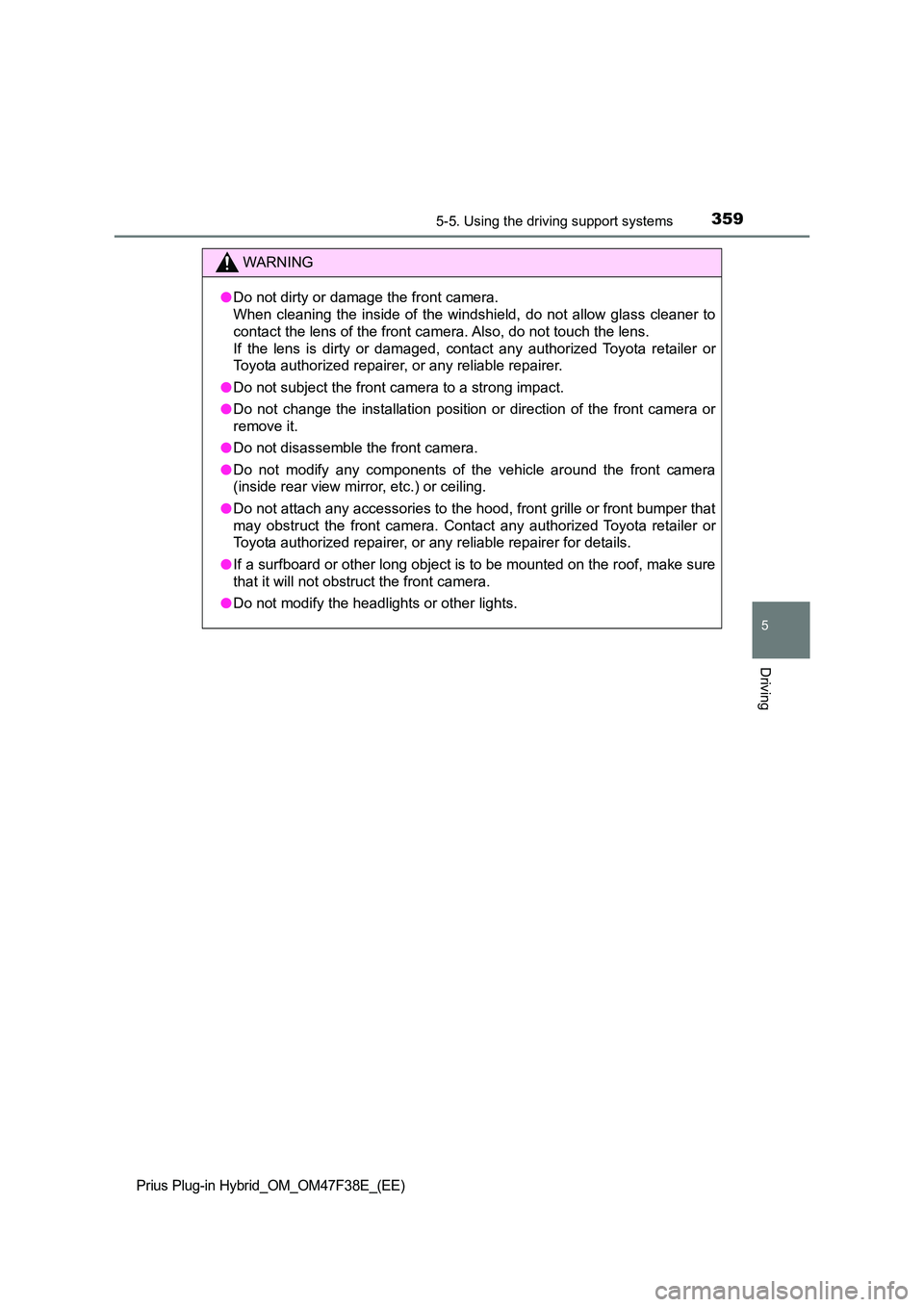
3595-5. Using the driving support systems
Prius Plug-in Hybrid_OM_OM47F38E_(EE)
5
Driving
WARNING
●Do not dirty or damage the front camera.
When cleaning the inside of the windshi eld, do not allow glass cleaner to
contact the lens of the front camera. Also, do not touch the lens.
If the lens is dirty or damaged, contact any authorized Toyota retailer or
Toyota authorized repairer, or any reliable repairer.
● Do not subject the front camera to a strong impact.
● Do not change the installation position or direction of the front camera or
remove it.
● Do not disassemble the front camera.
● Do not modify any components of the vehicle around the front camera
(inside rear view mirror, etc.) or ceiling.
● Do not attach any accessories to the hood, front grille or front bumper that
may obstruct the front camera. Contact any authorized Toyota retailer or
Toyota authorized repairer, or any reliable repairer for details.
● If a surfboard or other long object is to be mounted on the roof, make sure
that it will not obstruct the front camera.
● Do not modify the headlights or other lights.
Page 379 of 818
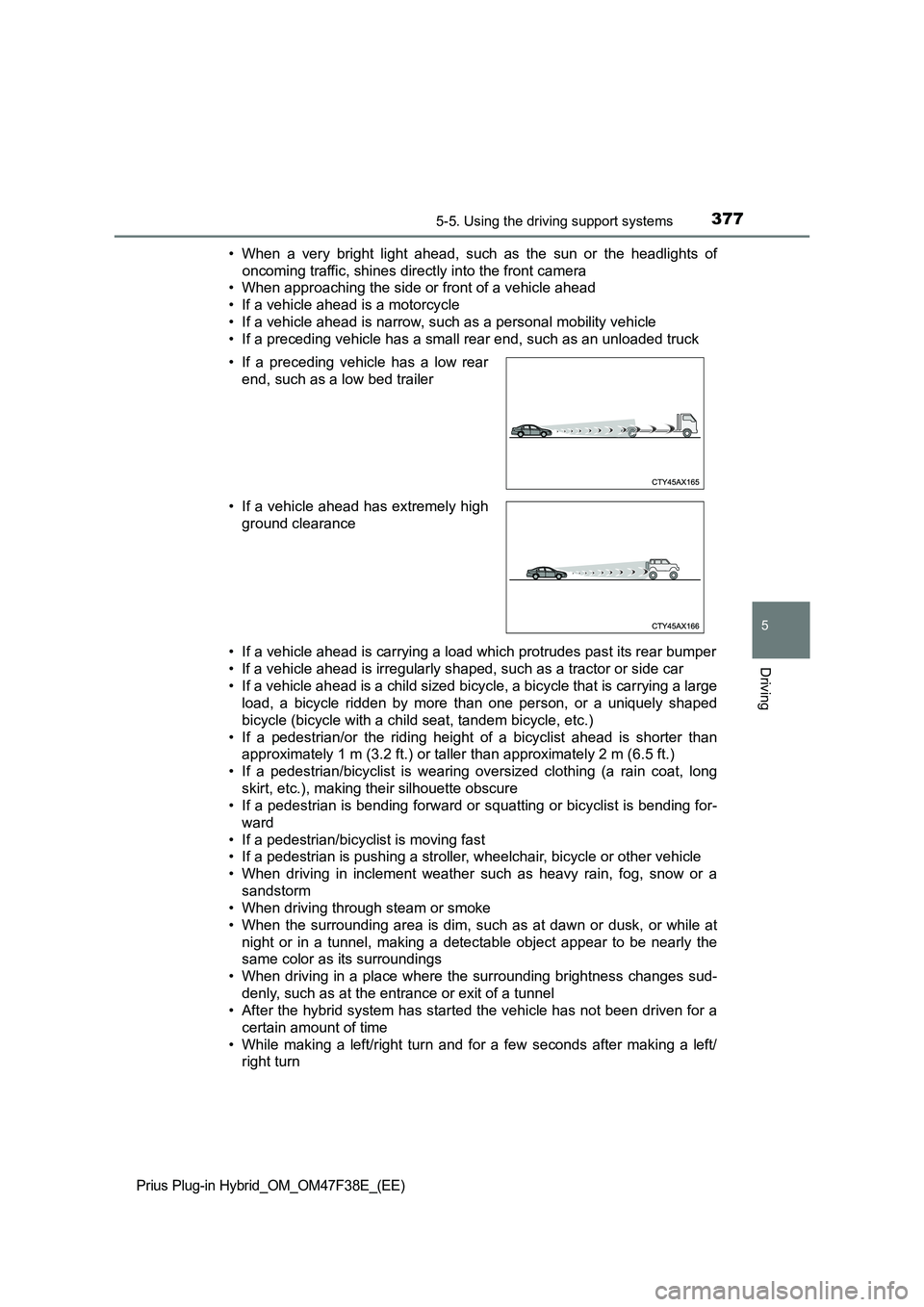
3775-5. Using the driving support systems
Prius Plug-in Hybrid_OM_OM47F38E_(EE)
5
Driving
• When a very bright light ahead, such as the sun or the headlights of
oncoming traffic, shines directly into the front camera
• When approaching the side or front of a vehicle ahead
• If a vehicle ahead is a motorcycle
• If a vehicle ahead is narrow, such as a personal mobility vehicle
• If a preceding vehicle has a small rear end, such as an unloaded truck
• If a vehicle ahead is carrying a load which protrudes past its rear bumper
• If a vehicle ahead is irregularly shaped, such as a tractor or side car
• If a vehicle ahead is a child sized bicycle, a bicycle that is carrying a large
load, a bicycle ridden by more than one person, or a uniquely shaped
bicycle (bicycle with a child seat, tandem bicycle, etc.)
• If a pedestrian/or the riding height of a bicyclist ahead is shorter than
approximately 1 m (3.2 ft.) or taller than approximately 2 m (6.5 ft.)
• If a pedestrian/bicyclist is wearing oversized clothing (a rain coat, long
skirt, etc.), making their silhouette obscure
• If a pedestrian is bending forward or squatting or bicyclist is bending for-
ward
• If a pedestrian/bicyclist is moving fast
• If a pedestrian is pushing a stroller, wheelchair, bicycle or other vehicle
• When driving in inclement weather such as heavy rain, fog, snow or a
sandstorm
• When driving through steam or smoke
• When the surrounding area is dim, such as at dawn or dusk, or while at
night or in a tunnel, making a detectable object appear to be nearly the
same color as its surroundings
• When driving in a place where the surrounding brightness changes sud-
denly, such as at the entrance or exit of a tunnel
• After the hybrid system has started the vehicle has not been driven for a
certain amount of time
• While making a left/right turn and for a few seconds after making a left/
right turn • If a preceding vehicle has a low rear
end, such as a low bed trailer
• If a vehicle ahead has extremely high
ground clearance